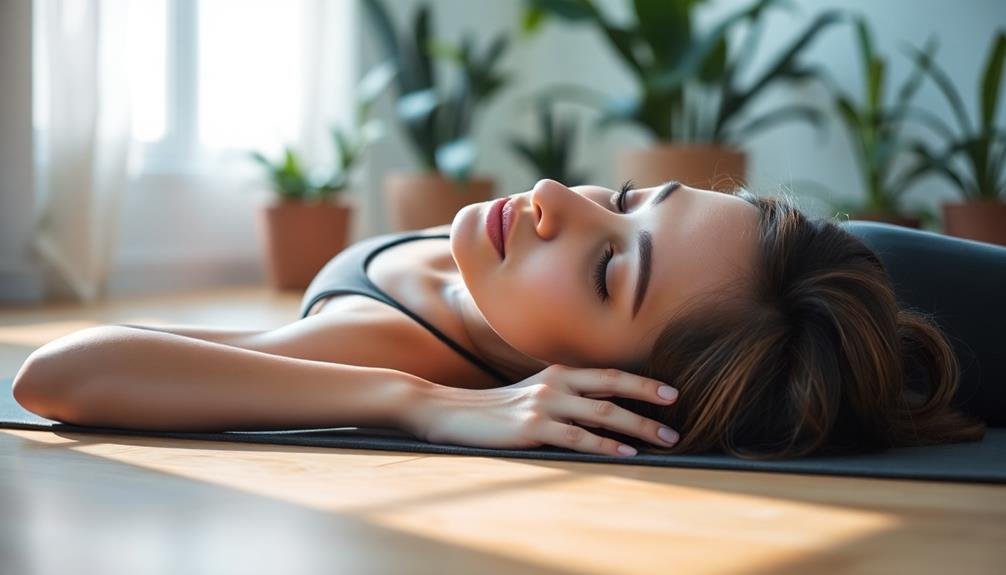You can conquer everyday stress with these five powerful mindfulness techniques. Start with mindful breathing to anchor your attention in the present moment. Try body scan meditation to cultivate deeper awareness of physical sensations. Practice gratitude journaling to shift your focus to life's positives. Engage in mindful walking to combine physical movement with mental focus. Use progressive muscle relaxation to systematically release tension throughout your body. Each technique is easy to learn and can be practiced anywhere. By incorporating these practices into your daily routine, you'll develop greater calm and resilience in the face of stress. Discover how these simple yet effective methods can transform your approach to daily challenges.
Key Takeaways
- Practice mindful breathing to anchor attention in the present moment and foster greater calm.
- Perform body scan meditation to cultivate awareness of physical sensations and reduce tension.
- Engage in gratitude journaling to shift focus to positive aspects of life and counteract stress.
- Use mindful walking techniques to combine physical movement with mental focus, improving mood.
- Apply progressive muscle relaxation to systematically release body tension and enhance mindfulness.
Mindful Breathing Exercise

One of the simplest and most effective mindfulness techniques is the mindful breathing exercise. This practice allows you to focus on your breath, anchoring your attention to the present moment and calming your mind.
To begin, find a comfortable position, either sitting or lying down. Close your eyes and take a few deep breaths to settle in. Now, direct your attention to your natural breathing rhythm. Notice the sensation of air entering and leaving your nostrils or the rise and fall of your chest and abdomen.
As you continue to breathe, you'll likely find that your mind wanders. This is normal. When you notice your thoughts drifting, gently redirect your focus back to your breath without judgment. You're not trying to clear your mind; instead, you're practicing awareness and returning to the present.
Start with just five minutes daily and gradually increase the duration as you become more comfortable. You can practice this exercise anywhere, anytime – at your desk, during your commute, or before bed.
Consistent practice will help you develop a greater sense of calm and improve your ability to manage stress throughout your day.
Body Scan Meditation

Through the practice of body scan meditation, you can cultivate a deeper awareness of your physical sensations and release tension throughout your body. This technique involves systematically focusing your attention on different parts of your body, from your toes to the top of your head.
As you progress, you'll notice areas of tightness, discomfort, or relaxation, allowing you to consciously release any held tension.
To begin, find a comfortable position, either lying down or sitting upright. Close your eyes and take a few deep breaths to center yourself. Start by bringing your attention to your toes, noticing any sensations present. Gradually move your focus up through your feet, ankles, legs, and so on, until you reach the crown of your head.
Body scan meditation offers several benefits:
- Increases body awareness
- Reduces physical tension and stress
- Improves sleep quality
As you practice regularly, you'll become more attuned to your body's signals and better equipped to manage stress.
This heightened awareness can lead to improved overall well-being and a greater sense of calm in your daily life.
Gratitude Journaling Practice

While body scan meditation focuses on physical awareness, gratitude journaling shifts our attention to the positive aspects of our lives. This practice involves regularly writing down things you're thankful for, helping to cultivate a more optimistic mindset and reduce stress.
To start gratitude journaling, set aside a few minutes each day, preferably at the same time. Choose a notebook or digital app that you'll enjoy using. Begin by listing three to five things you're grateful for, no matter how small. These can range from a delicious meal to a kind gesture from a friend or a personal achievement.
Be specific in your entries. Instead of writing "I'm grateful for my family," try "I'm grateful for my sister's supportive phone call today." This detail helps you relive positive moments and amplify their impact.
Don't worry if you repeat items; consistency is more important than variety. As you continue this practice, you'll likely notice a shift in your perspective. You'll become more attuned to positive experiences throughout your day, naturally counteracting stress and negative thoughts.
Mindful Walking Technique

Mindful walking offers a dynamic approach to meditation, combining physical movement with mental focus. You can practice this technique anywhere, from a quiet park to a busy city street. As you walk, shift your attention to the sensation of your feet touching the ground, the rhythm of your breath, and the movement of your body through space.
To begin, choose a safe path and set a comfortable pace. Focus on each step, noticing how your weight shifts from heel to toe. Breathe naturally and observe the air entering and leaving your lungs. If your mind wanders, gently bring your attention back to your body and breath.
As you become more comfortable with the practice, expand your awareness to include:
- The sights, sounds, and smells around you
- The temperature and texture of the air on your skin
- The subtle movements of your arms and torso
Mindful walking can help reduce stress, improve mood, and increase overall well-being. It's an excellent way to incorporate mindfulness into your daily routine, especially if you find sitting meditation challenging.
With regular practice, you'll develop a greater sense of presence and connection to your surroundings.
Progressive Muscle Relaxation

Progressive muscle relaxation offers another powerful technique for reducing stress and promoting mindfulness. This method involves systematically tensing and relaxing different muscle groups throughout your body. By focusing on the sensations of tension and release, you'll become more aware of your physical state and learn to distinguish between relaxed and tense muscles.
To practice progressive muscle relaxation, find a quiet space where you won't be disturbed. Lie down or sit comfortably, and close your eyes. Begin with your toes and work your way up to your head, tensing each muscle group for 5-10 seconds before releasing. As you release, focus on the feeling of relaxation spreading through your body.
Here's a guide to help you through the process:
| Muscle Group | Tension Action | Release Action |
|---|---|---|
| Feet | Curl toes tightly | Relax and spread toes |
| Legs | Straighten and lift | Lower and relax |
| Abdomen | Tighten stomach muscles | Release and breathe deeply |
| Hands | Clench fists | Open hands and relax fingers |
| Face | Scrunch facial muscles | Relax all facial muscles |
With regular practice, you'll find it easier to identify and release tension in your body, leading to improved stress management and overall well-being.
Frequently Asked Questions
How Long Does It Take to See Results From Practicing Mindfulness Techniques?
You'll notice initial benefits from mindfulness techniques within a few weeks of consistent practice. However, significant changes can take months. It's important to be patient and persistent, as everyone's journey is unique. Stick with it!
Can Mindfulness Techniques Help With Chronic Pain Management?
Yes, mindfulness techniques can help with chronic pain management. You'll learn to observe your pain without judgment, reducing its emotional impact. It's not a cure, but you'll develop better coping skills and potentially decrease pain intensity.
Are There Any Potential Side Effects of Practicing Mindfulness Regularly?
While mindfulness is generally safe, you might experience some temporary discomfort. You could feel increased anxiety, unpleasant memories, or heightened emotions. It's important to practice with guidance if you have a history of trauma or mental health issues.
How Can I Incorporate Mindfulness Into a Busy Work Schedule?
You can incorporate mindfulness into your busy work schedule by taking short breaks for deep breathing, practicing mindful eating during lunch, setting reminders for brief meditation sessions, and staying present during routine tasks like walking or typing.
Is It Necessary to Practice Mindfulness in a Quiet Environment?
You don't need a quiet environment for mindfulness. While it's helpful, you can practice anywhere. Focus on your breath or sensations during daily activities. It's about being present, not your surroundings. Try it during commutes or breaks.
In Summary
You've now got five powerful mindfulness techniques at your fingertips to combat everyday stress. Remember, consistency is key. Make these practices a part of your daily routine, and you'll soon notice a significant shift in your stress levels. Don't be discouraged if you struggle at first; mindfulness is a skill that improves with time. Be patient with yourself, stay committed, and you'll reap the benefits of a calmer, more centered life. Start today!





Leave a Reply